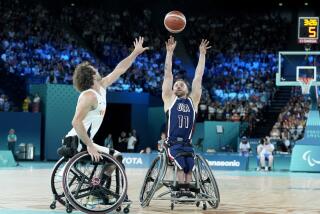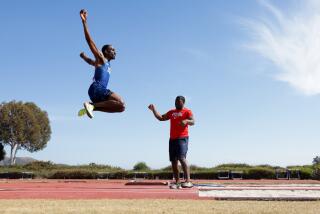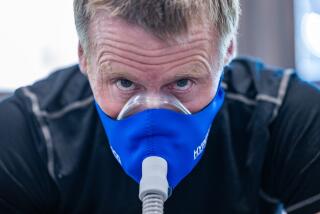Handicapped Skiers Don’t Find the Sport an Uphill Struggle
Like a lot of Californians, Steve Dubin enjoys skiing. And like a lot of Californians, Dubin had problems his first time on the slopes. But his problems were a lot different from those experienced by other skiers.
“The first time I skied, in Aspen, there was a real equilibrium problem,” said Dubin, a 32-year-old lawyer who has been skiing 10 years. “You don’t know where your body is, but then you figure it out. And you have a good time.”
Dubin’s difficulties were not the result of lack of coordination or anxiety that comes from challenging a new sport. Dubin is blind, a handicap which hasn’t prevented him from doing anything, including taking on a mountain. He skis with a guide, Randy Benson, who yells commands to help Dubin see what his eyes cannot.
Dubin participates in a Pierce College ski program for amputees and the blind or paraplegic. Once a week during the ski season, they come together, and their handicaps disappear at the base of the hill.
Dee Armstrong, who walks with the uneven gait a of a Larson’s Syndrome victim, doesn’t have to use her crutches when she skis. To hold herself up on the snow, Armstrong uses “outriggers,” poles fitted with miniature skis at the ends. The poles are equipped with a braking system that allows her to ski gracefully and safely without worry.
“I certainly don’t get that feeling walking,” the 20-year-old Pierce College student said. “Walking’s kind of a drag.
“I ski better than I walk, much faster. It offers me the kind of freedom other sports wouldn’t offer a handicapped person. See, I’m used to walking on crutches. With skis, I don’t have to take any steps and I don’t get off balance too much.”
Armstrong, who was told by doctors that he would never walk without crutches and pain, has been skiing for two years and recently qualified to be a guide for the Pierce program, helping other handicapped skiers.
“She’s a gutsy little lady,” said Lynne Haile, director of the program for the last 10 years. “It was really exciting to watch Dee ski for the first time and have that freedom of movement.”
For the guides, who are strong and able-bodied, the program offers a chance to be the eyes for a blind skier or the strength for a polio victim.
“It makes you say, ‘Gee, I don’t really have any problems,’ ” said Mike Monaco of his experience as a guide at Pierce. “It’s very humbling.”
The Pierce group may not have looked like kin as it prepared for a day of skiing at Mountain High recently, but skiers who watched the special equipment being lugged onto the snow and saw the able-bodied and handicapped skiers working side by side noticed a special bond.
One of the Pierce skiers, Todd Slowey, powered his wheelchair over the snow and ice to a flat spot, where he was helped into a sit-ski by Steve Glaab, a 19-year-old guide. Glaab lifted Slowey out of the chair and settled him into the ski. A waterproof blanket was then smoothed over Slowey’s straightened legs and he was belted into the fiberglass sled.
After firmly grasping outriggers, Slowey pushed himself to the chair lift. The two skiers rode side by side, Glaab with his legs dangling, and Slowey with his legs straight out, encased in the sit-ski. As the top of the mountain approached, Slowey pushed his body off the lift and bounced down to the snow.
Slowey is accustomed to the jolt that happens when the sled hits the slippery ground. He used to race motorcycles over dirt hills and enjoyed the bumpy ride.
“It’s similar,” said Slowey, who was paralyzed from the waist down after falling off a building. “You can get air off the moguls, the same feeling I used to get on a motorcycle.”
This year Pierce has two sit-ski sleds, one each for Slowey and Bruce Van Hoorn, who also lost the use of his legs in an accident four years ago. The two met while recuperating for two weeks at the same hospital. Nearly two years later they met again at Pierce. Now, they challenge each other’s ability to overcome the events that have so changed their lives.
The idea of including paraplegics on Pierce’s weekly ski trips came from twin brothers Mike and Mario Mangiaracina. At Mountain High, brothers took turns with the Glaab brothers, Steve and Hank, in guiding Slowey and Van Hoorn down the run. The guide must connect himself to the sit-ski with a tether, or rope, for control and safety because of the high speed Van Hoorn and Slowey reach.
“These guys blow the other skiers off the mountain,” Mario said of the sit-skiers. “They can go straight down the mountain with no problem. That’s why I always ski with them.”
It may have been a balance problem that caused Terry Almy to slip off the chairlift while on a Pierce ski trip in January. The blind skier was enjoying her first day on skis and because of a communication mix-up between her and her guide, she fell 30 feet to the frozen ground below.
Almy broke a leg and several other bones and had to be air-lifted to a hospital in Los Angeles. Almy, also a sky-diver, is now recuperating in the hospital and she has told Haile that she plans to ski again, although not for some time.
Haile said that the accident was the first in the program’s 10-year history.
“It was an unfortunate accident,” Haile said. “But I feel that our guides are well-trained and that skiing involves responsibility on the part of the skiers whether they’re handicapped or not. And it involves risks whether they’re handicapped or not.”
To help minimize the risks, the guides go through hours of training. As part of the exercise, a guide must “try out” the various handicaps. The able-bodied skiers put on blindfolds and ski with a certified instructor in order to understand the importance of verbal commands.
“I went through the blind clinic and skied blindfolded,” said Bob Schell, a Pierce student and recently certified guide. “And if I was blind, I wouldn’t want to ski. Not knowing what it’s like now, and knowing how to ski normally.
Hank Glaab, who has been with the program for four years, agrees that the blindfold training takes away one’s sense of balance and leaves the feeling of tumbling even after the skies have stopped.
“You think it’s going to be a piece of cake once you get the blindfold on,” said Dan Barton, a member of the program since 1978. “But you can’t tell 5 from 25 m.p.h. when you’re blind. Motion all seems the same. You have a spinning sense in your head.
“It makes the guides realize that it’s not something to be taken lightly, but to take caution with.”
Barton, 24, is a member of the ski patrol for Mt. Waterman and is known for his speed, his full-circle helicopter jumps, and his ability to calmly guide a blind skier around the slow beginning skiers who litter the mountain.
“Their lifeline is your voice,” Barton said.
By the end of the day at Mountain High, the guides’ voices were raspy from yelling commands. Haile gave the word and the group started the transformation back to reality--wheelchairs and crutches, sports cars and running shoes.
Despite a lack of snow and an abundance of rocks on the runs because of the warm weather, Haile was satisfied with the day’s accomplishments.
“The conditions weren’t that good,” Haile said. “But we had a good time. It’s great when we all get together.”
The idea for the program was sparked by a blind woman Haile had in her dance class at Pierce. Haile, who had skied most of her life, asked the woman if she’d be willing to try on skis. When the student agreed, Haile took her up to Mountain High. And then down it. It was then that Haile decided to include other handicapped people in her ski course.
Haile has received funding for the program, which costs about $7,000 a year to operate, through the California Handicapped Ski Foundation and Identity, a group that supplied the money for the sit-skis. Eighty people, including 20 handicapped skiers, are enrolled in the program for college credits or through Pierce’s Community Services.
Haile said that no matter what financial problems may affect the Los Angeles Community College District, the Pierce program will continue to find financing.
“The program gives disabled people, especially recently disabled people, a normal experience, an experience that makes them realize that they can compete with able-bodied people,” Haile said. “And it gives the able-bodied people the chance to share their skills with the handicapped.
“It all boils down to being equal. The skiing equalizes us.”


